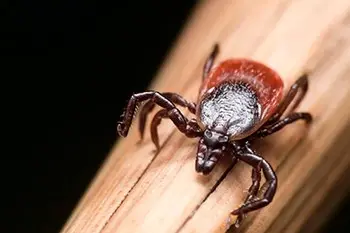Lyme Disease in Horses
Updated September 3, 2024

There’s nothing fun about finding a tick nestled deep in your horse’s mane when you’re busy braiding for a show, or reaching down to pick your horse’s hoof, only to find a mysterious lump on his leg. But ticks are more than just gross, they can be hazardous to the health of your horse. Ticks can transmit a variety of diseases to horses, one of the most serious being Lyme disease.
What is Lyme Disease?
Lyme disease is caused by a bacterial infection Borrelia burgdorferi that is spread by the blacklegged tick (deer tick). Horses, dogs, humans, and other mammals can all contract Lyme disease. It is most prevalent in New England, and the surrounding states of Pennsylvania, New York, New Jersey, Maryland, and Virginia, as well as the upper Midwest (Wisconsin and Minnesota).
Living in an area where these ticks also call home does put your horse at risk of contracting the Borrelia infection. However, if a tick carrying the B. burgdorferi bacteria bites your horse, it does not necessarily mean they will develop the disease.
Researchers have learned that if an infected tick is found and completely removed before 24 hours, transmission of the bacteria (and consequently developing the disease) can be prevented. Horses that were bitten, whether it was years ago or just last week, may remain infected (with positive serology results) but not develop the clinical disease.
Video on Lyme Disease in Horses
In this video, Dr. Lydia Gray discusses the most commonly recognized signs of Lyme disease, treatment options, and why it's important for owners to work with their veterinarian.
Signs and Symptoms of Lyme Disease in Horses
Clinical signs of Lyme disease in horses are vague, encompassing many different systems. Signs may not develop until 5 or 6 weeks after the horse is bitten. Symptoms may include:
- sporadic or shifting lameness
- joint pain or arthritis
- stiffness, muscle tenderness or soreness
- muscle atrophy or wasting
- chronic weight loss
- lethargy
- hypersensitivity to being touched
- uveitis (eye inflammation)
- poor performance
- skin nodules
- nuchal bursitis
Some symptoms may result from inflammation at the tick bite itself and not the Borrelia organism. Horses may also demonstrate neurological symptoms, such as behavioral changes, difficulty swallowing, a head tilt, paresis or weakness, and ataxia (unable to voluntarily control movement or the gait).
Diagnosing Lyme Disease in Horses
There is no “gold standard” to definitively diagnose horses with Lyme disease, so veterinarians use these four criteria:
- The horse lives in or traveled to an area where the disease is prevalent.
- The clinical signs shown are consistent with Lyme disease.
- Other potential causes of these clinical signs have been ruled out (the most important step).
- Based on immunological testing, the horse has a high antibody titer to the bacteria (although horses with uveitis and neurologic disease often do not have positive serum titers).
Veterinarians have several blood test options (Snap 4Dx, whole cell and multiplex ELISA, and Western blot) to determine the horse’s exposure to the bacteria and subsequent presence of antibodies. Your vet will select the best testing method given the unique situation.
Short and Long-Term Treatment
The tetracycline family of antibiotics seems to be effective against B. burgdorferi, including extended courses of oxytetracycline, doxycycline, or minocycline. Although even these medications may not completely eliminate the organism from the body.
In horses and other species, a low-level infection can persist. This can cause the condition to become chronic in a small number of horses who will require added rounds of even lengthier treatment. In addition, the particular system targeted by the infection (musculoskeletal, neurological, eye, etc.) may also require anti-inflammatory, complementary therapies, or other medications.
Supplements That May Lend Support
Horses with Lyme disease may benefit from supplements with ingredients that provide general wellness support – such as omega 3 fatty acids, antioxidants, and adaptogens -- as well as support towards specific affected areas.
For example, horses that are displaying joint discomfort may appreciate traditional ingredients that support and protect cartilage and connective tissues, such as glucosamine, chondroitin sulfate, hyaluronic acid, and MSM. Also look for turmeric, resveratrol, collagen, and various herbs to support a normal inflammatory response. Muscle recovery can often use an assist from amino acids like lysine, methionine, threonine, and others. Both muscle and neurological systems may find value in the addition of Vitamin E which protects the body from damaging free radicals.
Digestive support from probiotics, prebiotics, and yeast during a course of antibiotics is regularly recommended to help maintain normal, healthy gastrointestinal function. They act as reinforcement for gastric (stomach) tissues under stress with ingredients like soothing herbs, soluble (mucilage) fiber, and buffering agents.
Management and Prevention of Lyme Disease
Unfortunately, there is currently no approved vaccine to prevent Lyme disease in horses. Until an equine vaccine becomes readily available, the best way to protect your horse is by preventing tick bites.
Horse owners who live in tick-infested areas should follow advice to reduce exposure of their animals (and themselves) to these parasites, such as:
- Avoiding woods or forests.
- Removing brush, leaves, and tall grass.
- Protect the horse by using insect sprays and repellents.
- Performing full-body “tick checks” for horse and rider routinely.
- Discourage animals such as deer, birds, and rodents that form a part of the life-cycle of ticks and help them spread.
Questions to Ask Your Veterinarian
- What is the prognosis for a full recovery if my horse has Lyme disease– that is, what are the long-term effects?
- Should Lyme disease be considered as a differential diagnosis if some of the same signs and symptoms are present?